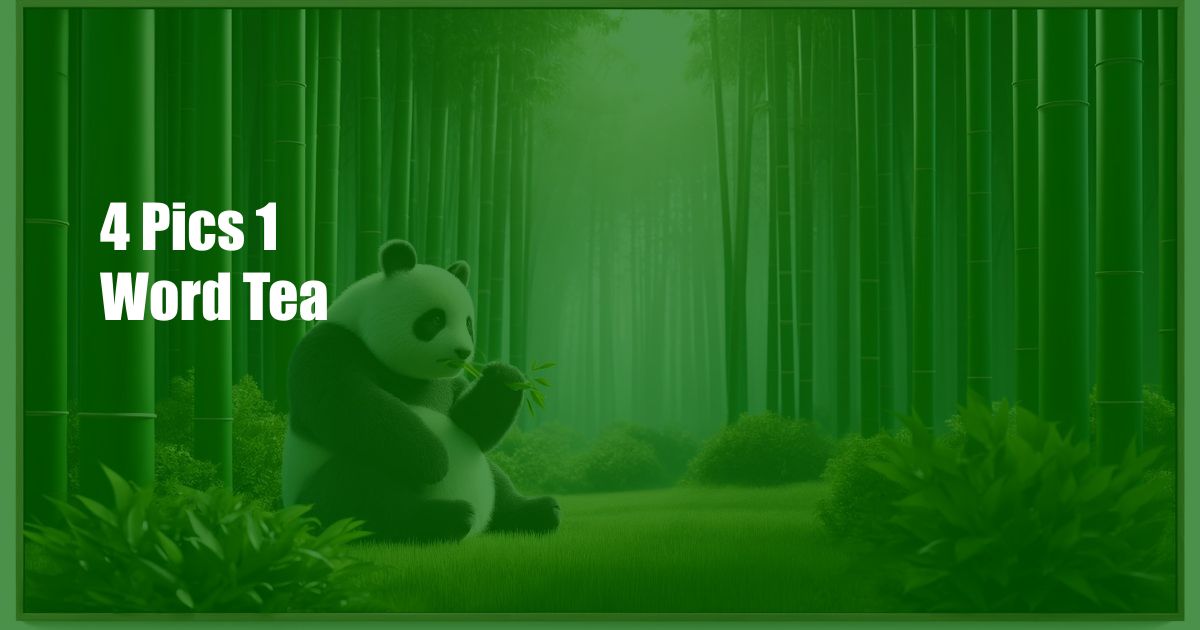
4 Pics 1 Word: Tea – An Enchanting Beverage with a Rich History
In the tapestry of beverages, tea stands as an aromatic and flavorful thread, deeply entwined with cultures across the globe. Its captivating infusion, inviting aroma, and timeless tradition have stirred the senses for centuries, inspiring poets, artists, and tea connoisseurs alike.
The origins of tea, shrouded in the mists of time, trace back to ancient China, where legend whispers of Emperor Shennong’s accidental discovery. As he boiled water beneath a wild tea tree, leaves fluttered into the bubbling cauldron, releasing an intoxicating scent that captivated the senses. From that moment onward, tea embarked on its global journey, becoming an indispensable part of daily life and cultural rituals.
Tea: A Botanical Wonder with Diverse Varieties
Tea, derived from the leaves of the Camellia sinensis plant, encompasses a vast spectrum of varieties, each boasting unique characteristics. Black tea, with its robust flavor and deep amber hue, owes its intensity to the oxidation process it undergoes. Green tea, on the other hand, undergoes minimal oxidation, retaining its delicate grassy notes and vibrant emerald color.
Oolong tea, a semi-oxidized variety, bridges the gap between black and green teas, offering a versatile range of flavors and aromas. White tea, the least processed of all, exudes a subtle sweetness and delicate floral undertones. Rooibos tea, derived from the Aspalathus linearis plant, offers a caffeine-free alternative with earthy and slightly sweet notes.
The Health Benefits of Tea: A Treasure Trove of Antioxidants
Beyond its sensory allure, tea holds a wealth of health benefits. Rich in polyphenols, potent antioxidants, tea helps neutralize free radicals, protecting our bodies from cellular damage. Studies have linked regular tea consumption to reduced risks of certain chronic diseases, including heart disease, cancer, and Alzheimer’s.
Green tea, in particular, has garnered significant attention for its high concentration of epigallocatechin gallate (EGCG), a powerful antioxidant linked to improved brain function and weight loss. However, it’s important to note that tea should be consumed in moderation, as excessive intake can interfere with iron absorption.
Tea Rituals: A Tapestry of Cultural Traditions
Tea has woven itself into the fabric of cultures worldwide, inspiring a diverse array of rituals and ceremonies. In China, the art of tea brewing and appreciation has been elevated to a form of high culture, steeped in symbolism and tradition. The Japanese tea ceremony, known as chanoyu, is a ritualized form of tea preparation and consumption, emphasizing harmony, respect, purity, and tranquility.
In the United Kingdom, afternoon tea has become a quintessential tradition, a delightful indulgence enjoyed with friends and family. From the formal tea parties of high society to the cozy tea breaks of common folk, tea has become an integral part of British culture.
Tips for Brewing the Perfect Cup of Tea
To fully savor the aromatic delights of tea, meticulous attention to the brewing process is essential. Start with high-quality loose-leaf tea, as it offers a more flavorful and nuanced experience. Use freshly drawn, filtered water, as impurities can alter the taste. The ideal water temperature varies depending on the type of tea, but generally, boiling water is suitable for black tea, while lower temperatures are recommended for green and white teas.
Steeping time is another crucial factor. For black tea, a steeping time of 3-5 minutes allows the flavors to fully develop. Green tea, on the other hand, requires a shorter steeping time of 2-3 minutes to prevent bitterness. Experiment with different steeping times to find the perfect balance for your taste buds.
FAQs on 4 Pics 1 Word: Tea
Q: What is the most popular type of tea?
A: Black tea is the most widely consumed type of tea globally, accounting for approximately 78% of total tea production.
Q: Can tea help improve sleep?
A: Certain teas, such as chamomile and lavender, have calming effects that may promote relaxation and improve sleep quality.
Q: What is the difference between tea and herbal tea?
A: True tea is derived from the leaves of the Camellia sinensis plant, while herbal teas are made from the leaves, roots, seeds, or flowers of other plants.
Q: Is tea naturally caffeine-free?
A: No, all teas except herbal teas naturally contain caffeine. The amount of caffeine varies depending on the type of tea and the brewing method.
Q: Is it better to drink tea hot or cold?
A: Both hot and cold tea offer health benefits, but hot tea may have a more potent antioxidant effect due to the higher temperature.
Conclusion
4 Pics 1 Word: Tea is an immersive journey into the world of this enchanting beverage, from its ancient origins to its modern-day iterations. Whether enjoyed as a solitary indulgence or shared in convivial company, tea continues to captivate with its timeless flavors, health-giving properties, and rich cultural tapestry.
Is exploring the captivating world of tea an adventure that sparks your curiosity? If so, immerse yourself in the aromatic realm and let the flavors and traditions of tea ignite your senses and enrich your life.
 Azdikamal.com Trusted Information and Education News Media
Azdikamal.com Trusted Information and Education News Media